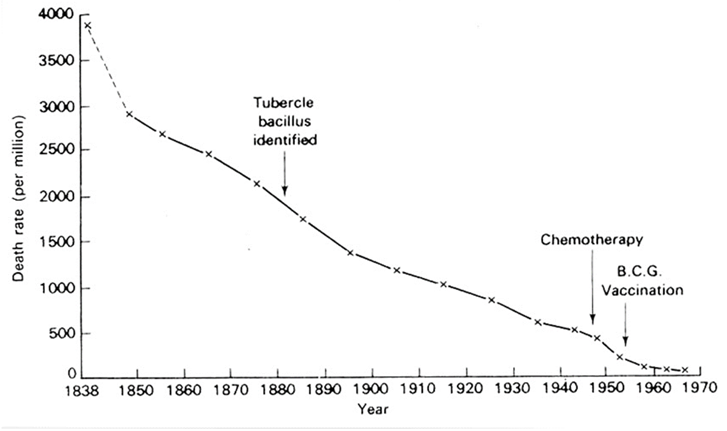Mortality by cause and the McKeown debate
1/15
There's no tags or description
Looks like no tags are added yet.
Name | Mastery | Learn | Test | Matching | Spaced |
|---|
No study sessions yet.
16 Terms
What are other names for respiratory TB?
Phthisis or consumption
Who identified the tubercle bacillus, when, and what was it associated with?
In 1882 Robert Koch identified the tubercle bacillus (Mycobacterium tuberculosis), which is associated with the rise of germ theory and the demystification of TB
What was TB previously thought to be?
Inherited, a spiritual affliction, romantic/beautiful, shift away from miasma, etc
How did the discovery of the bacillus impact perceptions and policy around TB?
This didn’t lead to cures immediately, but did have impacts on prevention measures because it placed it in the realm of human control
Focus shifted to preventing the contagion and what could be changed about society
Ths led to many anti-TB campaigns (anti-spitting laws, impure milk) and attempts to ameliorate social conditions like poverty, eventually leading to the sanatorium movement
What was McKeown’s thesis from the Modern Rise of Population?
Demographic transition with variation and fluctuations of increasing/decreasing mortality and fertility from the 17th to 20th centuries
Suggested mortality decline was driving population increase, challenged orthodoxy that medical advancements were the cause and instead suggested improved standard of living (especially nutrition) that improved resistance
Also that the decline in infectious disease deaths, mainly TB, was the direct driver because it had such a big impact and was declining
What was Szreter’s dispute regarding the McKeown thesis?
Szreter argues that economic growth was not necessarily tied to improved health and that the decline in airborne diseases more related to sanitation and hygiene (not medical, more public health measures)
Particularly with the decline in infant/child mortality
What is generally believed to have led to declining infant and child mortality in the 19th and 20th centuries?
The decline is usually attributed to many factors, like improved housing, domestic hygiene, local health and maternity services, safe milk supply (milk depots in France, US, Canada, not much in the UK), and increasing interest in infant health
The decline for infants probably occurred later because these big public health interventions took time to reach the home, where infants usually are
The 1907 Notification of Births Act in Britain also played a role so healthcare personnel could visit and help/educate on motherhood
According to Rollet (1997), what were the stages of infant mortality?
1860s-1870s - perception of infant mortality as a social and demographic issue
1880s-1890s - focus on infantile diarrhoea and milk safety
1900-1910s - role of mothers, tied to history of eugenics and childhood health to ensure healthy soldiers
1920s-1930s - family context
How does the McKeown thesis relate to politics and identity?
Belief in a certain approach shaped interpretation of the data, didn’t really consider all options
McKeown thesis provided rationale for governments not spending more on health services
According to Szreter (1988, 2002), Colgrove (2002), and Grundy (2005), why is it problematic to look at the impacts of infectious diseases separately?
Because comorbidities exist and can increase mortality risk (could otherwise be attributed to just one or the other)
According to Szreter (1988, 2002), Colgrove (2002), and Grundy (2005), what issues may arise from grouping diseases together?
Variation may be ignored, causing it to be inaccurate
What was the result of McKeown grouping diseases together?
McKeown grouped a lot of airborne infectious diseases together, positing better nutrition/life quality post-industrial revolution as an explanation for reduced airborne disease incidences, but variation was missed as it really only applied to TB, skewed results
According to Szreter (, Colgrove (2002), and Grundy (2005), why is it important to reexamine old theories about mortality decline?
They should be reexamined as we get new methods and information to ensure they are accurate
McKeown’s hypothesis was pretty well accepted but new information and research methods revealed the flaws and generalisations with his hypothesis (he used deduction without properly ruling out other options, and he didn’t have all the info)
Attitudes, biases, and allocations of cause of death can change over time
According to Szreter (1988, 2002), what is the lesson from the British case?
Local governments and other institutions can have a significant impact on population health as long as they have direction
Medical advances or universal healthcare are not needed for improved and expanded public health infrastructure/initiatives to be effective, although it’s helpful to reduce mortality quickly
Slower methods are useful when political and/or economic factors may make longer-term options unviable, like with Victorian Britain
What levels of intervention are needed to make meaningful improvements to public health?
Both broad and small-scale measures are required to improve public health
Addressing the source of the problem (inequality)
But also equity and more targeted intervention locally

What does this graph depict?
The decline in TB related deaths over time with indicators for when the bacillus was identified, and when medical treatments came into play
The decrease began long before any medical intervention, although it did fall more quickly afterwards
This was used by McKeown to support his thesis that nutrition and better quality of life was to blame for decreasing TB deaths, not medical interventions or public health initiatives